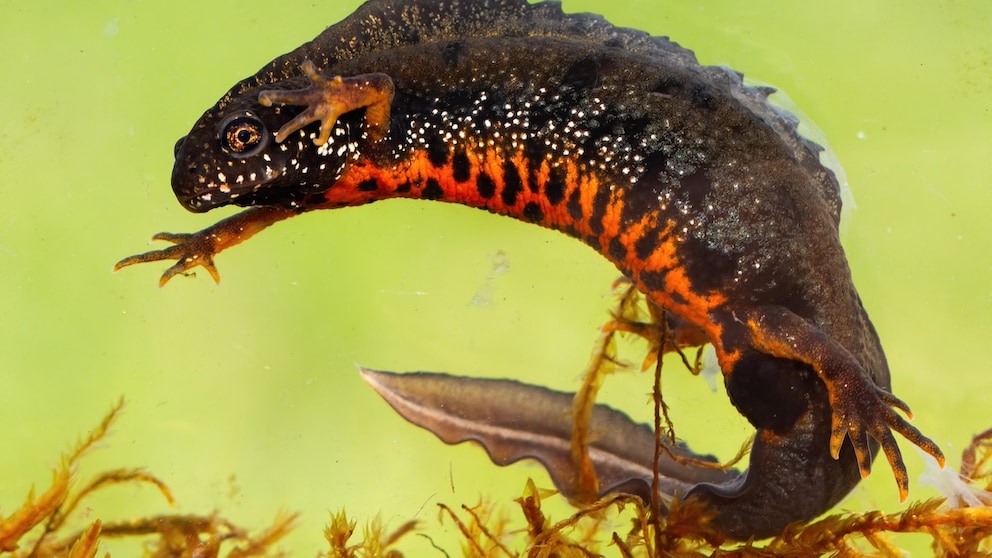July 26, 2024, 7:31 am | Read time: 5 minutes
In a garden, a small pond with hiding places and retreats is enough for newts. But can newt fans also keep these fascinating animals at home? PETBOOK provides tips on how to keep newts in an aquarium or terrarium in a species-appropriate way.
If you have a garden pond, you can take certain measures to ensure that exciting amphibians such as the pond newt, the great crested newt, the alpine newt or the thread newt can establish themselves. But are these fascinating-tailed amphibians also suitable as pets? If you want to keep newts in an aquarium or terrarium in a species-appropriate way, there are a few things to keep in mind. Before buying and setting up an artificial habitat like this, it is crucial to decide which species of newt to choose. Pet stores offer a variety of newts, including alpine newts, smooth newts, palmate newts, fire-bellied newts, Italian newts, crocodile newts, as well as Turkish and Persian mountain newts. Dwarf and ribbed newts are particularly popular among beginners, and the unique axolotl is also available. It is strictly forbidden to take these animals from the wild.
Overview
What equipment do you need to keep newts in a species-appropriate way?
As most newts need both water and land, their home would be called an aqua terrarium. With appropriate care and the right food, newts can lead a species-appropriate life and usually live for 10 to 20 years! The basis of this is the right equipment:
The tank
First, choosing the right tank size is crucial. For four adult animals of the small green newts or a solitary axolotl, the tank should have a volume of at least 60 × 40 × 40 cm (23.6 × 15.7 × 15.7 inches), i.e., 96 liters (ca. 25 gallons). For larger species such as the labial or crocodile newt, you need at least 80 × 50 × 50 cm (31.5 × 19.7 × 19.7 inches), i.e., 200 liters (52.8 gallons). This is also the appropriate size for keeping two axolotls. You should be aware of the special characteristics of these animals, e.g., that they are excellent climbers, and therefore the tank must be completely covered if you don’t want to find your newt half-dried out in the crack of the sofa.
Heating rod
Most newt species require an air and water temperature between 64 and 72 degrees Fahrenheit. This is generated by a heating rod. At night, however, the temperature should drop to around 59 degrees Fahrenheit. You should also find out in advance whether the newts go into hibernation. Species such as the smooth newt do this and only require a temperature of 50 to 61 degrees Fahrenheit for one to two months.
Thermometer and hygrometer
The thermometer and hygrometer measure the temperature and humidity values. The latter must not fall below 60 percent during the day and 80 percent at night. The smaller the airspace in the aqua terrarium, the more carefully you should ensure sufficient ventilation and keep an eye on the values.
Light
To keep newts in a species-appropriate environment, the animals need about 11 hours of light a day. This is best provided by fluorescent tubes or LED lamps. Direct sunlight should be avoided at all costs, otherwise the tank will quickly overheat.
A timer
If you don’t want to be constantly checking when to switch the light on and off or turn the temperature up or down, it’s better to rely on a timer.
How do you set up a species-appropriate home for newts?
As soon as the technology is in place, a suitable location should be chosen for the aqua terrarium. The tank should be in a quiet place that is not exposed to drafts or direct sunlight. The tank should be placed on a foam mat on a cabinet. This should be able to safely support the weight of the filled tank. The structure and dimensions of the base must be created in relation to the size of the tank. Now it’s time to set up the tank.
The ground substrate
It is important for the newt to have a firm substrate so that it can sometimes go ashore. This should always be moist. An absorbent substrate made of coconut fibers, moss, or terrarium soil is therefore suitable.
Retreats and hiding places
As in the wild, newts also need a way to hide from prying eyes in their artificial habitat. Suitable hiding places include coconut shells and cork tubes.
Plants
Aquatic and floating plants also provide hiding places for newts and oxygen for the larvae (tadpoles) to breathe through their gills, as they stabilize the quality of the water. Species from the Cryptocoryne family or the larger sword plants (Echinodorus) are particularly suitable for this purpose. As newts become quite active, you should avoid using delicate aquatic plants, as these will quickly be damaged by them.
How do you feed newts appropriately?
Newts do not gnaw on algae stalks, as they are pure carnivores. They are fed — preferably on land, with tweezers — with food animals that you can collect yourself: earthworms, slugs, isopods, insects, arachnids or mosquito larvae, water fleas, freshwater shrimps, and many more.
You can also purchase or cultivate live food such as crickets, mealworms, fly larvae, mosquito larvae, tubifex worms, and daphnia. You can also feed them strips of meat or fish. Commercially prepared pellets are also available in pet stores.

How to Keep Tortoises Outdoors

How to keep chameleons in a species-appropriate way

How to Keep and Care for Sticklebacks in an Aquarium or Garden Pond
Sources
- Nanoaquaristik.com, „Paludarium: Das Aqua-Terrarium in deinem Wohnzimmer“ (accessed on 12.2.2023)
- Mein-nano-aquarium.de, „Das Nano-Aquarium einrichten: das musst Du beachten!“ (accessed on 12.2.2023)
- Aquascaping-berlin.de, „Das Nanoaquarium – kleiner Blickfang mit großer Wirkung“ (accessed on 12.2.2023)

